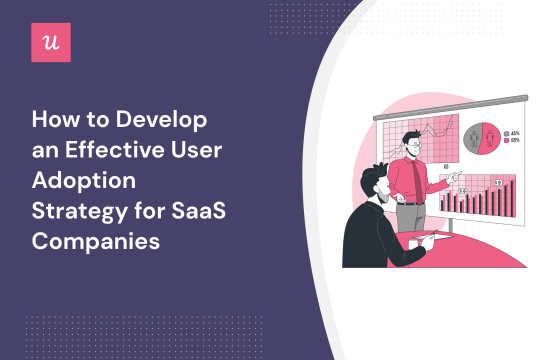What’s a user adoption strategy? How do you create one? What tools and techniques can you use to implement it?
These are the key questions that we cover in this article. So if you’re after these answers, you couldn’t be in a better place!
Let’s jump straight in.
TL;DR
- A user adoption strategy is a plan for user education and onboarding so that they progress smoothly toward activation and adoption.
- An effective product adoption strategy improves user activation, reduces friction and customer churn, and boosts product success.
- To build your strategy, use a user adoption strategy template.
- Start by identifying your target audience and building user personas. Focus on their JTBDs and problems.
- Next, define adoption goals for each user persona. Adoption goals describe events completed by the user that tell you they’ve adopted the product.
- For all user personas, you also need to map out the activation points. These are the points in the user journey where they experience value leading up to their adoption goals.
- Once you have the goals and activation points, look for ways to guide users and enable them to achieve them. For example, in-app guidance or self-help.
- After implementing the techniques, track their effectiveness with product analytics and user feedback.
- Use event analytics and funnel analysis to track user progress through individual activation points, and milestone analysis to see if they’ve reached the key stages.
- Leverage user feedback to gauge the overall sentiment and identify ways to improve your strategy.
- The metrics that you can use to track how well users adopt your product include Monthly Active Users (MAUs), Customer Lifetime Value (CLV), product adoption rate, and customer churn rate.
- To test the changes to your strategy and techniques, run A/B tests.
- Personalizing user onboarding for each user segment is one way to improve the adoption rate and customer lifetime value.
- Look for friction points and remove them to help users activate.
- Onboarding checklists and in-app messages will help you onboard your users and help them develop the right level of competence.
- Analyzing the paths taken by your power users will help you identify successful behaviors that other users can replicate.
- Userpilot is a product adoption platform that enables product teams to analyze user behavior and collect feedback to inform your strategy.
- You can then implement it with in-app messages, checklists, interactive walkthroughs, and a resource center.
What is user adoption?
User adoption is the process by which a new user becomes familiar with and starts using a new product or service.
A successful user adoption process might involve providing user onboarding, product education, and in-app guidance to ensure that users have the necessary knowledge and skills to use the product and realize its value.
What is a user adoption strategy?
User adoption strategy is a plan that outlines the tactics and resources that you use to gradually guide users through the stages of the adoption process, from the moment they experience its value to the moment they turn into your product advocates.
To achieve this, the strategy needs to take into account user needs and objectives, the actions they need to take to achieve them, and the pain points they face in their journey.
Why is it important to have a user adoption strategy in place?
A well-planned user adoption strategy is crucial to the success of your SaaS product. Without such a strategy in place, it can be challenging to attract, engage, and retain users. In the long run, this affects product growth.
The key benefits of a robust user adoption strategy include:
- Improved user activation: it helps new users experience the product value and they start seeing it as a go-to solution for their problems.
- Increased customer success: it enables your users to satisfy their needs and wants more efficiently.
- Reduced friction and customer churn: it shows users the optimal way to complete their tasks which reduces the risk of them dropping off.
How can product managers create a successful strategy to improve user adoption rates?
Let’s look at how you can build a robust user adoption strategy to drive your product and business goals.
Identify your user personas
The process of building your user adoption strategy begins by identifying your target audience.
While your users may share some characteristics, the odds are you will have a few distinct user personas with their unique needs and goals. Each of them will require a bespoke approach to ensure they achieve their objectives in the least possible time.
Once you have a list of possible personas, use a template to record the relevant information about their:
- Jobs to be done
- Company details
- Pains and problems
- Role in the company and team collaborations
- Benefits of using your product
For example, if your product is accounting software, your user personas could be:
- A freelancer
- An accountant

Define user adoption goals
Once you have your user personas lined up, define the goals that each of them needs to achieve. This will tell you whether they’ve adopted the product or not.
The goals depend on the product. For your accounting software, the goals could be:
- A freelancer: create and share at least one invoice for three consecutive months
- An accountant: send a referral link to 3 new clients
Define user activation points in the user journey
After identifying the goals for each of the user personas, move to map out the activation points in each of their journeys.
What are activation points?
In short, these are the steps that users need to complete to achieve their goals. At each of them, they experience the product value.
So, for a freelancer using the accounting app, examples of activation points would be:
- Create a user account
- Set up the account with all the details like social security number
- Connect the bank account
- Save a photo of a receipt
- Save client details
- Create an invoice
- Share the invoice
- Invite an accountant to review your accounts.
Execute techniques to achieve product adoption goals
Once you map out the activation points and goals for each user persona, choose the best approach to help them reach their objectives.
For example, you could use the onboarding checklist to help the user set up their account, in-app messages to prompt them to create an invoice at the end of the month, and an interactive walkthrough to help them create one and share it with the client.
Once you have the plan, record it in an activation playbook. And put the plan in motion to start driving adoption, of course.

Track the success of your product adoption strategy
Implementing the plan is only part of the job. Now it’s time to track how successful it is and tweak it accordingly.
Here are a few ways to determine how well the plan works and find ways to improve it.
Event analytics
Events are all the actions users complete in the product, e.g., clicking on a CTA button or using a feature.
Many analytics tools allow you to create custom events that combine a few actions and track them as one. So you could create a custom event for saving client details, creating an invoice, sharing it, and receiving payment.
While some analytics tools required injecting js code to track events, modern software like Userpilot enables you to do it without writing a single line of code.

Funnel analysis
A funnel is the sequence of steps or actions leading up to the goal. In our case, that’s all the activation points.
The important thing is each step leads to the next one. If the user drops off at one stage, they fail to achieve their goals. For example, if they fail to connect their bank account to their account, they won’t be able to collect payments from their clients.
Funnel analysis allows you to find friction points. If you see that users slow down or drop off at a particular stage, you can investigate further to understand what’s causing it.
Milestone analysis
Milestones are the key steps that users achieve on their journey toward activation and adoption.
For example, receiving the first payment after issuing and sharing an invoice could be an example of a milestone.
Most dedicated analytics tools and adoption tools offer goal-setting and tracking features, so milestone analysis shouldn’t be an issue if you’ve done your homework and identified adoption goals for your user personas.

User feedback surveys
Apart from product usage analytics, you can get valuable insights from user surveys.
For example, you could use them to gather feedback on the user onboarding experience while NPS surveys will give you an indication of how loyal your customers are.
Following them up with qualitative questions, can shed light on issues that users experience and help you identify areas for improvement.
You can also use surveys to segment your users so that you can personalize your adoption strategy even further. For example, you could target users experiencing a specific pain point with bespoke in-app guidance to help them overcome the issue.

Metrics to track the success of your user adoption strategy
There are a bunch of metrics that can help you evaluate the effectiveness of your user adoption strategy.
- Monthly Active Users (MAUs): if your strategy is effective, this number grows because your users find value in the product and keep using it.
- Customer Lifetime Value (CLV): that’s all the revenue that an average user brings over the duration of their business relationship; high CLV means users stay with the product and upgrade to higher plans.
- Product adoption rate: it’s an indication of how many users use the product on a regular basis.
- Customer churn rate: high user churn means that the product doesn’t deliver enough value for users to stay.
Learn from results to further streamline the user adoption process
It goes without saying that there’s no point in collecting product analytics and user feedback data if you don’t act on it to improve your strategy.
For example, if your users fail to reach an activation point or reach a goal, you could look at their product usage to see if there are any common patterns in their behavior. There could be features that they don’t engage with and this leads to them churning.
At this point, you could tweak your onboarding flows and A/B test them to see if the changes bring better results.

Examples of user adoption strategies you can implement in your SaaS
So what exactly can product or customer success teams do to drive user adoption? Here are a few best practices that you could experiment with.
Personalize the onboarding process to increase the customer lifetime value
Personalized user onboarding is the name of the game. After all, why would you overload your users with irrelevant information and introduce features that are of no use for their use cases?
Start by collecting information about your users and their JTBDs with the welcome survey. At this stage, you will know which user persona you’re dealing with.
Use the information to segment your users and unleash the user adoption tactics that you’ve identified in your playbooks to guide them through the key features and sections of the product that they need to accomplish their goals.

Reduce adoption friction with a frictionless onboarding process
The sooner your users experience the product value, the more likely they are to stay and convert into paying customers. That’s why you need to make your onboarding process as frictionless as possible.
To achieve this, use analytics to track how your users progress along the customer journey toward activation. Watch out for stages where users slow down or drop off – you should follow up, and eliminate them one by one to optimize the flows.

Boost product adoption with onboarding checklists
Checklists are one of the most effective onboarding tools. There’s nothing more satisfying than ticking off one item after another, especially if it gets you closer and closer to your goal.
Here are a few pro tips on how to create effective checklists:
- Keep them short – 4-5 items will do.
- Focus on core features.
- Add a progress bar.
- Include actions the user has already completed like creating the account to boost their motivation.

Drive user engagement with in-app guidance
In-app guidance is great for both primary and secondary onboarding.
For example, you can launch an interactive walkthrough to help users complete a task for the first time.
Later on, you can use a modal or tooltip to drive engagement with features that are relevant to their use cases but they haven’t used yet.
Tooltips are also great for introducing new features just like the Calendly tooltip below.

Use in-app messaging to drive adoption
In-app messages are an effective way to communicate product updates to your users.
Let’s imagine your users have been asking for certain features or updates. You’ve decided to act on the request and have just released the update. You can then trigger a modal to bring them up-to-date with the changes, targeting the users who requested them in particular.
In this way, you make sure they don’t miss it, increase the chances they use it and demonstrate you’re ready to act on their feedback.

Replicate the path taken by power users
Making your less successful users emulate what your power users do is an easy way to improve user adoption.
How do you go about it?
- Use analytics, like a funnel or cohort analysis, to identify your most successful users.
- Use a tool like Amplitude Pathfinder to map their in-app behavior and find out how they go about achieving their goals.
- Use in-app guidance to make other users with similar JTBDs replicate their happy paths.

How to create and execute a good user adoption strategy with a digital adoption platform?
There are a number of dedicated analytics, feedback, and engagement tools that could help you plan and execute your user adoption strategy. Alternatively, you could use a digital adoption platform like Userpilot that will cover all your needs.
Here’s a breakdown of the relevant features Userpilot offers:
- Chrome extension for a code-free feature and event tagging.
- Heatmaps.
- Goal tracking for milestone analysis.
- Funnel analysis and paths (coming soon).
Feedback
- In-app surveys, including NPS analytics and qualitative response tagging.
Engagement
- UX patterns for in-app messaging (tooltips, modals, banners, slideouts, hotspots and driven actions).
- Onboarding checklists (with analytics).
- Resource center for self-help (with analytics).
- A/B testing for in-app flows.
- WYSIWYG editor for UX pattern customization.
Conclusion
A solid user adoption strategy will improve user activation, reduce friction and customer churn, and boost customer success.
To achieve better product adoption, devise a bespoke strategy for each user persona. Track its effectiveness with product analytics and user feedback, and adjust accordingly.
If you want to see how Userpilot can help you design, implement and review your product adoption strategy, book the demo!
The post How to Develop an Effective User Adoption Strategy for SaaS Companies appeared first on Thoughts about Product Adoption, User Onboarding and Good UX | Userpilot Blog.





![11-product-management-fundamentals-[+-strategies-&-examples]](https://prodsens.live/wp-content/uploads/2024/09/27484-11-product-management-fundamentals-strategies-examples-380x250.png)